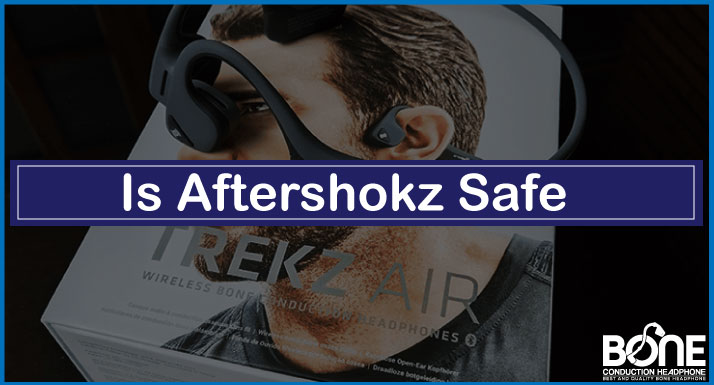With the ever-evolving audio tech landscape, bone-conduction headphones like Aftershokz have been making waves. These nifty devices ditch the traditional ear canal route and instead transmit sound through vibrations straight to your inner ear, using the bones in your skull. However, innovations always raise questions about safety for human health.
Therefore, in this article, we’re going to discuss the safety of Aftershokz headphones, addressing common concerns and giving you the lowdown on whether they’re a safe choice for your audio adventures. Let’s jump right in!
Is Aftershokz Safe?
When comparing the safety of Aftershokz to traditional headphones, it’s important to consider the specific risks involved. Traditional over-ear headphones can pose a risk by isolating the listener from their surroundings, potentially affecting their ability to hear oncoming traffic or other potential dangers.
Additionally, if used at high volumes, over-ear headphones can pose a risk to the eardrum due to the direct air pressure on a small surface area.
On the other hand, bone-conduction headphones like Aftershokz bypass the eardrum entirely, reducing the risk of eardrum damage. They also allow for better awareness of the surroundings as they don’t cover the ears. Moreover, bone-conduction headphones can be easily cleaned and are less likely to transmit diseases if shared.
Overall, in safe listening environments, Aftershokz bone-conduction headphones can be considered a safer option compared to traditional headphones.
What are the Side Effects of AfterShokz?
AfterShokz headphones are generally considered safe to use, with minimal reported side effects. However, some individuals may experience minor discomfort, pressure on the bones surrounding the ears, or headaches during extended use.
Additionally, excessive volume levels can potentially lead to hearing damage, including tinnitus (ringing in the ears) or exacerbating existing hearing conditions.
While AfterShokz aims to prioritize safety, it’s important to be mindful of your volume settings and take breaks to prevent potential issues such as dizziness or migraines. If you experience any persistent discomfort or adverse effects, it is recommended to consult a healthcare professional.
Is Bone Conduction Technology Safe?
Bone conduction technology is generally considered safe for most individuals. By bypassing the ear canal, it reduces the risk of eardrum damage associated with traditional headphones.
However, as with any audio device, it’s important to use bone conduction technology responsibly. Excessive volume levels can still lead to potential hearing damage or exacerbate existing conditions.
Additionally, some users may experience minor discomfort or pressure on the bones surrounding the ears during extended use. Adhering to recommended volume levels, taking breaks, and being mindful of personal comfort is key to ensuring the safe and enjoyable use of bone conduction technology. If any concerns arise, consulting a healthcare professional is advised.
Is Bone Conduction Safer than Earbuds?
Bone-conduction headphones are generally considered safer compared to earbuds because they do not exert direct pressure on the ear canal, minimizing strain on ear muscles and bones. They are a preferred option for individuals with specific needs.
Additionally, unlike earbuds, bone-conduction headphones allow users to hear ambient noises as they do not block the ear canal. This feature is beneficial for activities like running or listening to music while remaining aware of the surrounding environment.
By bypassing the ear canal, bone-conduction headphones provide a more comfortable and potentially safer listening experience, particularly for those who require headphones with minimal impact on the ear canal.
Can AfterShokz Cause Vertigo?
Bone conduction headphones can potentially cause vertigo in individuals who are susceptible to this condition, particularly when they expose themselves to high volume levels. Symptoms may include headaches, dizziness, nausea, and soreness of the eyes with blurred vision.
While rare, the vibrations transmitted through the bones of the skull could trigger these symptoms. It’s crucial for individuals prone to vertigo to use bone conduction headphones responsibly, adhering to recommended volume limits and taking breaks during prolonged use.
If symptoms persist or worsen, seeking medical advice is recommended to ensure a safe listening experience.
Wrap Up
AfterShokz bone conduction headphones provide a safer option compared to traditional headphones. Whether you’re running, cycling, or engaging in athletic activities, you can enjoy your music without compromising your awareness and safety. Moreover, they minimize the risk of hearing damage and ensure a comfortable listening experience. So, go ahead and pursue your active lifestyle with peace of mind.
FAQs
Can you answer calls on AfterShokz?
With AfterShokz, you can enjoy both bone-conduction audio and the ability to take calls. Since all wireless models have dual noise-canceling microphones, allowing you to answer calls when paired with a smartphone or Bluetooth device. They also offer built-in call functionality for added convenience during phone conversations.
Can you sleep with AfterShokz?
Certainly! Bone conduction headphones provide the advantage of not exerting pressure on the outer ear or blocking the ear canal. This makes them suitable for individuals who enjoy listening to audio while sleeping.

